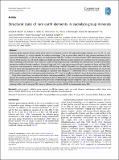Files in this item
Structural state of rare earth elements in eudialyte-group minerals
Item metadata
| dc.contributor.author | Borst, Anouk M. | |
| dc.contributor.author | Finch, Adrian A. | |
| dc.contributor.author | Friis, Henrik | |
| dc.contributor.author | Horsburgh, Nicky | |
| dc.contributor.author | Gamaletsos, Platon | |
| dc.contributor.author | Goettlicher, Joerg | |
| dc.contributor.author | Steininger, Ralph | |
| dc.contributor.author | Geraki, Kalotina | |
| dc.date.accessioned | 2020-01-13T00:36:38Z | |
| dc.date.available | 2020-01-13T00:36:38Z | |
| dc.date.issued | 2019-08-02 | |
| dc.identifier | 263137258 | |
| dc.identifier | 9f8a9879-b483-47a0-ad3e-c9d617bfacb8 | |
| dc.identifier | 85078558957 | |
| dc.identifier | 000535539400003 | |
| dc.identifier.citation | Borst , A M , Finch , A A , Friis , H , Horsburgh , N , Gamaletsos , P , Goettlicher , J , Steininger , R & Geraki , K 2019 , ' Structural state of rare earth elements in eudialyte-group minerals ' , Mineralogical Magazine , vol. FirstView . https://doi.org/10.1180/mgm.2019.50 | en |
| dc.identifier.issn | 0026-461X | |
| dc.identifier.other | ORCID: /0000-0002-3689-1517/work/64697274 | |
| dc.identifier.other | ORCID: /0000-0003-4553-9037/work/64698097 | |
| dc.identifier.other | ORCID: /0000-0003-0775-1491/work/65014432 | |
| dc.identifier.uri | https://hdl.handle.net/10023/19264 | |
| dc.description | This work was carried out under the NERC-funded SOS RARE consortium [grant NE/M010856/1 to AMB, NJH and AF]. We thank Diamond Light Source and KIT Karlsruhe Light Source for beam time at I18 [grants SP14793 and SP15903 to AMB and AF] and SUL-X, respectively. PG was funded by the People Programme (Marie Curie Actions) in the EU Seventh Framework Programme (FP7/2007-2013), REA grant agreement no. 609405 (COFUNDPostdocDTU). | en |
| dc.description.abstract | Eudialyte-group minerals (EGM) attract global interest as potential resources for high-field-strength elements (e.g. Zr, Nb, Ta, and rare-earth elements), i.e. critical materials for modern technologies. They are particularly valued for their relative enrichment in the most critical lanthanides, i.e. Nd and heavy rare earth elements (Gd–Lu). However, rare earth element (REE) substitution mechanisms into the EGM structure are still poorly understood. Light and heavy REE may occupy different sites and there may be ordering and/or defect clustering in the structure. This study uses X-ray absorption spectroscopy to determine the structural state of REE in EGM from prospective eudialyte-bearing complexes. Yttrium K-edge and Nd L3-edge spectra were collected as proxies for heavy and light REE, respectively, and compared to natural and synthetic REE-bearing standards. Extended X-ray absorption fine structure data yield best fits for Y in six-fold coordination with Y–O distances of 2.24–2.32 Å, and a second coordination sphere comprising Fe, Na, Ca, Si and O at radial distances of 3.6–3.8 Å. These findings are consistent with dominant Y3+ substitution for Ca2+ on the octahedral M1 site in all the samples studied, and exclude preferential substitution of Y3+ onto the smaller octahedral Z site or the large low-symmetry N4 site. Using lattice strain theory, we constructed relative partitioning models to predict site preferences of lanthanides we have not measured directly. The models predict that all REE are favoured on the Ca-dominant M1 site and that preferential partitioning of heavy over light REE increases in EGM containing significant Mn in the M1-octahedral rings (oneillite subgroup). Thus, the flat REE profiles that make EGM such attractive exploration targets are not due to preferential partitioning of light and heavy REE onto different sites. Instead, local ordering of Mn- and Ca-occupied M1 sites may influence the capacity of EGM to accommodate heavy REE. | |
| dc.format.extent | 16 | |
| dc.format.extent | 1368521 | |
| dc.language.iso | eng | |
| dc.relation.ispartof | Mineralogical Magazine | en |
| dc.subject | Critical metals | en |
| dc.subject | Eudialyte Group Materials | en |
| dc.subject | Peralkaline igneous rocks | en |
| dc.subject | Rare Earth Elements | en |
| dc.subject | Partitioning models | en |
| dc.subject | Lattice strain theory | en |
| dc.subject | XANES | en |
| dc.subject | EXAFS | en |
| dc.subject | X-ray absorption spectroscopy | en |
| dc.subject | High field strength elements | en |
| dc.subject | GE Environmental Sciences | en |
| dc.subject | NDAS | en |
| dc.subject.lcc | GE | en |
| dc.title | Structural state of rare earth elements in eudialyte-group minerals | en |
| dc.type | Journal article | en |
| dc.contributor.sponsor | NERC | en |
| dc.contributor.institution | University of St Andrews. School of Earth & Environmental Sciences | en |
| dc.contributor.institution | University of St Andrews. Scottish Oceans Institute | en |
| dc.contributor.institution | University of St Andrews. St Andrews Isotope Geochemistry | en |
| dc.identifier.doi | https://doi.org/10.1180/mgm.2019.50 | |
| dc.description.status | Peer reviewed | en |
| dc.identifier.grantnumber | NE/M010856/1 | en |
This item appears in the following Collection(s)
Items in the St Andrews Research Repository are protected by copyright, with all rights reserved, unless otherwise indicated.

